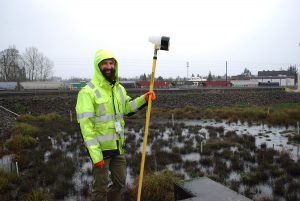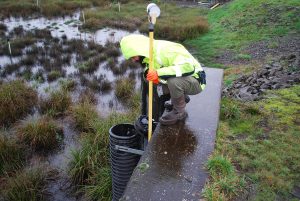Fieldwork with Phil: Stormwater
Precipitation is critical to our environment and ecosystem, but the journey of rain as it hits paved areas is a different story than that of the water cycle from your elementary school days.

Environmental Specialist Phillip Martello walked us through the complicated, but essential, permitting world of stormwater
According to the Environmental Protection Agency, stormwater runoff is generated from rain and snowmelt events that flow over land or impervious surfaces, such as paved streets, parking lots, and building rooftops, and does not soak into the ground. Stormwater is different than the wastewater or a sewer drain in a citizen’s home that discharges via pipes to a municipal treatment system. In truth, the majority of stormwater eventually flows directly into nearby receiving waterbodies such as streams, rivers and lakes, making regulations and treatment essential.
A simple and effective education strategy has been the “only rain down the storm drain” slogan to help everyone remember that there is a difference and that storm drains are only intended for stormwater. Port Environmental Specialist Phillip Martello walked us through the complicated, but essential, permitting world of stormwater.
“Under the State of Washington’s regulations to comply with the Clean Water Act, there are different types of permits that target the management of stormwater,” said Martello. “The port has three different types of stormwater permits: municipal, construction, and industrial.”

Rainy days mean busy work for Martello as he checks to see if water levels are high enough to take samples
Municipal:
“Due to the port owning and operating our municipal separate storm sewer system (MS4), we are required to have a municipal stormwater permit, operating much like a small city,” said Martello.
The port’s stormwater sheet flows into catch basins and pipes and is then conveyed to regional treatment systems and once treated discharges directly via outfalls into the Columbia River.
“For example, our Terminal 2 area has catch basins, storm drains and pipes that all drain toward the port’s biofiltration pond for treatment. There, stormwater is filtered through a compost/sand layer with the help of plants and microbes before it is discharged via port storm lines to an outfall to the river,” described Martello.
Construction:
Sediment is one of the most common pollutants in rivers, streams, lakes and reservoirs. The most concentrated sediment releases come from construction activities. Construction stormwater permits are required for any construction activities equal to or greater than one acre. An individual who is a Certified Erosion and Sediment Control Lead (CESCL) is required to do weekly construction site inspections and within 24 hours of a stormwater discharge from the site.
“CESCL inspections consist of visually checking that sediment isn’t leaving the construction site, as well as inspection of erosion control devices that have been installed to ensure they are still working properly. The CESCL also collects and samples stormwater for turbidity to confirm sediment is staying on-site,” said Martello.
Industrial:
Certain industrial activities at the port are required to obtain industrial stormwater permits. Some of the conditions of the industrial stormwater permit are monthly visual inspections and sampling quarterly for metals, pH, turbidity, hydrocarbons, and oil sheen. Port terminals covered under the industrial permit receive additional treatment technologies such as filter vaults, hydrodynamic separator units, catch basin filters, and the port’s floating treatment wetlands (FTWs) and Grattix boxes to filter out pollutants from stormwater before discharging to the Columbia River.
What’s Next:
With the goal of making sure that our stormwater is clean before discharging to the river, our environmental team has been coming up with innovative solutions such as the Grattix and floating treatment wetlands (FTWs). Next on the innovation front, is the potential utilization of oyster shells as a stormwater treatment.
“We’re taking inspiration from other ports and municipalities that have begun testing oyster shells to filter dissolved metals,” said Martello. “The plan is to test the use of oyster shells with stormwater from the port’s Terminal 4 pond to see if it reduces the zinc and copper level. If it does contribute to lower levels, we would look to use the shells in catch basins, a surface layer in Grattix units, and potentially in the pond itself.”
Keeping the air, land and water around us clean is a top priority at the Port of Vancouver USA. We believe that environmental stewardship and economic development can co-exist, and as part of our community, we are committed to doing our part. Having key policies and permits in place is critical for stormwater management and we continue to seek out innovative solutions to help keep our stormwater clean and look forward to sharing those ideas in the future.
